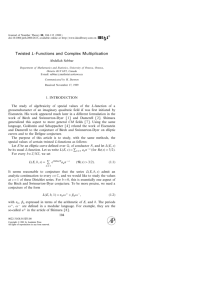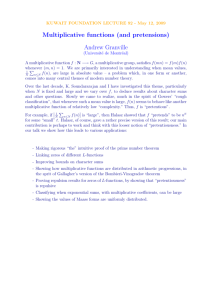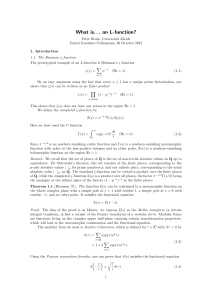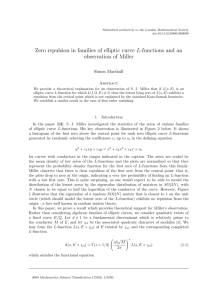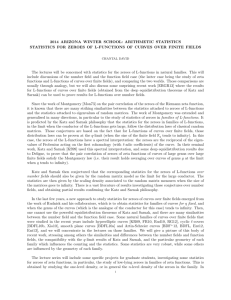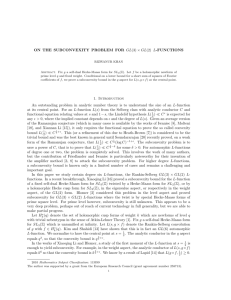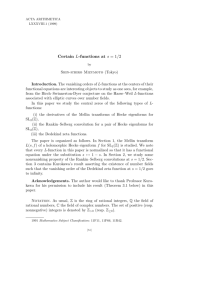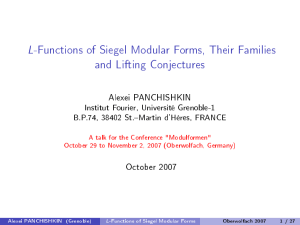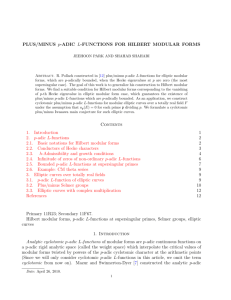L-functions and modular forms
advertisement
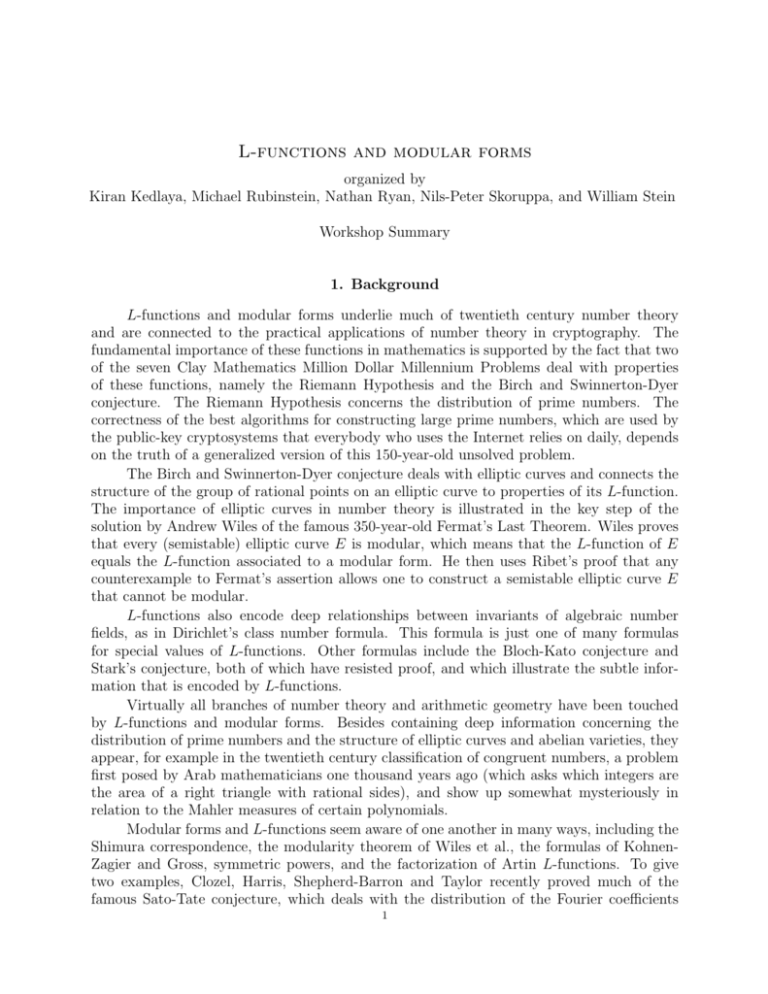
L-functions and modular forms organized by Kiran Kedlaya, Michael Rubinstein, Nathan Ryan, Nils-Peter Skoruppa, and William Stein Workshop Summary 1. Background L-functions and modular forms underlie much of twentieth century number theory and are connected to the practical applications of number theory in cryptography. The fundamental importance of these functions in mathematics is supported by the fact that two of the seven Clay Mathematics Million Dollar Millennium Problems deal with properties of these functions, namely the Riemann Hypothesis and the Birch and Swinnerton-Dyer conjecture. The Riemann Hypothesis concerns the distribution of prime numbers. The correctness of the best algorithms for constructing large prime numbers, which are used by the public-key cryptosystems that everybody who uses the Internet relies on daily, depends on the truth of a generalized version of this 150-year-old unsolved problem. The Birch and Swinnerton-Dyer conjecture deals with elliptic curves and connects the structure of the group of rational points on an elliptic curve to properties of its L-function. The importance of elliptic curves in number theory is illustrated in the key step of the solution by Andrew Wiles of the famous 350-year-old Fermat’s Last Theorem. Wiles proves that every (semistable) elliptic curve E is modular, which means that the L-function of E equals the L-function associated to a modular form. He then uses Ribet’s proof that any counterexample to Fermat’s assertion allows one to construct a semistable elliptic curve E that cannot be modular. L-functions also encode deep relationships between invariants of algebraic number fields, as in Dirichlet’s class number formula. This formula is just one of many formulas for special values of L-functions. Other formulas include the Bloch-Kato conjecture and Stark’s conjecture, both of which have resisted proof, and which illustrate the subtle information that is encoded by L-functions. Virtually all branches of number theory and arithmetic geometry have been touched by L-functions and modular forms. Besides containing deep information concerning the distribution of prime numbers and the structure of elliptic curves and abelian varieties, they appear, for example in the twentieth century classification of congruent numbers, a problem first posed by Arab mathematicians one thousand years ago (which asks which integers are the area of a right triangle with rational sides), and show up somewhat mysteriously in relation to the Mahler measures of certain polynomials. Modular forms and L-functions seem aware of one another in many ways, including the Shimura correspondence, the modularity theorem of Wiles et al., the formulas of KohnenZagier and Gross, symmetric powers, and the factorization of Artin L-functions. To give two examples, Clozel, Harris, Shepherd-Barron and Taylor recently proved much of the famous Sato-Tate conjecture, which deals with the distribution of the Fourier coefficients 1 2 of classical modular forms (or equivalently, the Dirichlet coefficients of its associated Lfunction), by proving that all the associated symmetric power L-functions are meromorphic with functional equation, and holomorphic for <(s) ≥ 1. Also, a theorem of Iwaniec, and Sarnak relates the existence of so-called Landau-Siegel zeros of degree 1 Dirichlet L-functions to averages of degree 2 L-functions associated to classical modular forms. L-functions arise in many ways, and these seem to connect to one another in ways that are not well understood: from modular forms, in terms of the solutions to algebraic varieties, and via representations of Galois groups. Two of the central ideas in number theory, the full Shimura-Taniyama conjecture for abelian varieties of GL(2) type (now an unpublished theorem of Khare, Wintenberger, et al.), and the Langlands program, describe how these points of view are related. The Shimura-Taniyama conjecture for elliptic curves that Wiles et al. proved is the special case of the former conjecture applied to elliptic curves. In spite of their central importance, we have only scratched the surface of these crucial and powerful functions. 2. Our workshop The purpose of the workshop was to examine the current state of theory, algorithms, and data for L-functions and modular forms, to define priorities in these areas, and to outline a large scale collaborative project aimed at carrying out research and implementing many of the ideas discussed during the workshop. At the workshop, participants discussed the current state and priorities for topics including: the Selberg Class, algorithms for L-functions, special values of L-functions, classical modular forms, classical Maass forms, higher rank modular forms, Artin L-functions, and encyclopedia and database issues. We formulated a list of important theoretical and algorithmic developments that are needed, outlined problems to work on and conjectures to be verified, and made a list of existing implementations and databases and a corresponding wish list. We also initiated a wiki as way to record discussions, to communicate, and to create a framework to help us begin charting the world of L-functions and modular forms. Besides discussions in smaller groups, several discussions involving all of the participants were held to try to organize a large scale collaborative project to develop theory and organize methods for understanding and computing with L-functions and modular forms. This broad project requires input from many experts on computational number theory, in particular algorithms for L-functions, and their associated classical modular forms, Maass forms, and more general modular forms, as well as theoreticians who have a broad view of these subjects. To this end, we have assembled a world class team of experts in these areas. Several of the workshop participants have banded together and have applied to the NSF for an FRG grant to allow this project to come to fruition. The PIs on the FRG proposal are: Andrew Booker, Brian Conrey, Noam Elkies, Michael Rubinstein, Peter Sarnak, and William Stein. The senior personnel are: Winfried Kohnen, Fernando Rodriguez-Villegas, Nathan Ryan, Fredrik Strömberg, Mark Watkins, and David Yuen. Nine of these people participated in our AIM workshop. 3 3. New project that resulted Broadly speaking, we plan to chart the landscape of L-functions and modular forms in a systematic and concrete fashion. We will develop important theory, create and improve algorithms for computing with L-functions and modular forms, discover properties of these functions, and test fundamental conjectures. The project will result in the creation of a vast amount of data about a wide range of modular forms and L-functions, which will far surpass in range and depth anything computed before in this area. We will generate this data in a systematic fashion and organize it in a freely available online data archive, along with the actual programs that were used to generate these tables. By providing these tables and tools online, we will guarantee that the usefulness of this project will extend far beyond the circle of researchers directly involved in the project. Our archive will be a rich source of examples and tools for researchers working on L-functions and modular forms for years to come, and will allow for future updates and expansion. These tables will be easily searchable both through online utilities and through a wiki that will organize our many tables into a theoretical framework. We also plan, at the end of our project, to produce a more refined published encyclopedia of L-functions and modular forms. Several factors make this an appropriate time for a concerted effort at organizing methods for L-functions and modular forms. The theory of degree 1 and 2 L-functions has reached a more mature form, but many of the basic formulas are still conjectural in higher degrees. Furthermore, many crucial and central conjectures have received scant, if any, testing in the case of higher degree, and limited testing in the case of degrees 1 and 2. We are now at a stage, theoretically and algorithmically, that we can tackle these issues and give them the high level of attention that they require. Algorithms for computing with both L-functions and various modular forms have been developed and some of them implemented, but these exist as independent entities, while the world of L-functions and modular forms are interrelated. These basic algorithms have reached a mature enough state so that combining them will be feasible and will allow for a systematic exploration and tabulation of degree 1, 2, 3, and 4 L-functions, as well as some higher degree L-functions. There is a recognized need to bring together these different ideas in order to investigate the world of L-functions and modular forms. Furthermore, computing power makes many questions that were out of reach a few years ago feasible, especially for higher degree L-functions. We plan to carry out a systematic study, theoretically, algorithmically, and experimentally, of degree 1, 2, 3, 4 L-functions and their associated modular forms, including classical modular forms, Maass forms for GL(2), GL(3), GL(4), Siegel modular forms, and Hilbert modular forms. We will also investigate symmetric square and cube L-functions, RankinSelberg convolution L-functions, the Hasse-Weil L-functions of algebraic varieties, Artin L-functions associated to 3- and 4-dimensional Galois representations, and, less systematically, look at a few high degree L-functions associated to higher symmetric powers and higher dimensional Galois representations. Our work will fall into four categories: theoretical, algorithmic, experimental, and data. The theoretical work will be stimulated by our goal of charting the world of Lfunctions and modular forms, and by the following needs: to extend lower degree results to higher degrees, to develop formulas that can then be applied to algorithms for computing 4 with these functions, and to understand lower degree conjectures by working out the correct formulation of higher degree conjectures. We will develop methods for storing representations of modular forms, L-functions, and related objects in a way that they can be immediately reconstructed and further data can be computed about them. This is critical both to make it easy to extend data, and to use parallel computation in certain situations. The free open source computer software that we create to generate the data will be tremendously useful for anyone requiring their own extensive datasets of these special Lvalues. They will all be made free available with complete source code in a form that is ready to use, extend, improve, or change. When possible, they will also be made part of Sage and of the L-functions Calculator, so that the source code will be peer reviewed. OUr archive will be a rich source of examples and tools for researchers working on L-functions and modular forms for years to come, and will allow for future updates and expansion.
